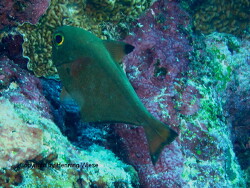Info
Pempheris vanicolensis Cuvier, 1831
This glass or hatchet fish got its name from the island Vanikoro (also called Banie), which belongs to the Solomon group.Due to the optical appearance of the animal, it was even said to have been found in the Mediterranean in the past, but in fact it was actually Pempheris mangula (Cuvier, 1829).
This point is interesting in so far as other existing species such as the subspecies from the Red Sea and the Indian Ocean, Pempheris flavicycla marisrubri and Pempheris flavicycla flavicycla, were also called Pempheris vanicolensis for a long time.Recent research by Randall, Bogorodsky, Alpermann, Satapoomin, Mooi & Mal, published in 2013, revealed this "secret".
Pempheris vanicolensis is found in shallow waters around rock and coral reefs, where these perches gather in groups for their protection and also go together in search of suitable zooplankton.During the day the animals hide in small caves and larger reef crevices.
Pempheris species are generally suitable for keeping in suitably large reef aquariums with suitable stocking, but they are not among the most active and strong swimming fish, they like to stand close to corals and are also very loyal during the day.
Besides live food the animals also like to accept frozen food (e.g. Mysis).s)
This glass or hatchet fish got its name from the island Vanikoro (also called Banie), which belongs to the Solomon group.Due to the optical appearance of the animal, it was even said to have been found in the Mediterranean in the past, but in fact it was actually Pempheris mangula (Cuvier, 1829).
This point is interesting in so far as other existing species such as the subspecies from the Red Sea and the Indian Ocean, Pempheris flavicycla marisrubri and Pempheris flavicycla flavicycla, were also called Pempheris vanicolensis for a long time.Recent research by Randall, Bogorodsky, Alpermann, Satapoomin, Mooi & Mal, published in 2013, revealed this "secret".
Pempheris vanicolensis is found in shallow waters around rock and coral reefs, where these perches gather in groups for their protection and also go together in search of suitable zooplankton.During the day the animals hide in small caves and larger reef crevices.
Pempheris species are generally suitable for keeping in suitably large reef aquariums with suitable stocking, but they are not among the most active and strong swimming fish, they like to stand close to corals and are also very loyal during the day.
Besides live food the animals also like to accept frozen food (e.g. Mysis).s)







 Jim Greenfield, Großbritannien
Jim Greenfield, Großbritannien















































